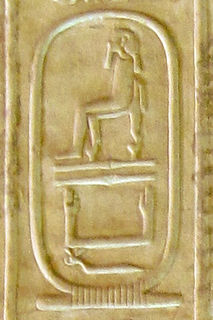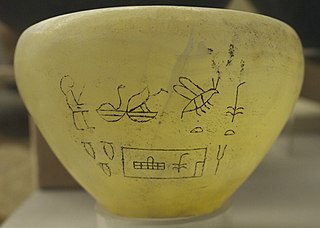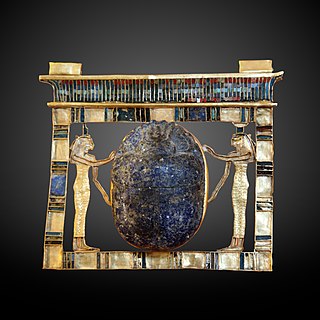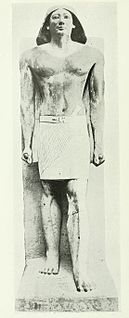
Unas or Wenis, also spelled Unis, was a pharaoh, the ninth and last ruler of the Fifth Dynasty of Egypt during the Old Kingdom. Unas reigned for 15 to 30 years in the mid-24th century BC, succeeding Djedkare Isesi, who might have been his father.

Memphis was the ancient capital of Inebu-hedj, the first nome of Lower Egypt. Its ruins are located near the town of Mit Rahina, 20 km (12 mi) south of Giza.

In Egyptian mythology, Ptah is the demiurge of Memphis, god of craftsmen and architects. In the triad of Memphis, he is the husband of Sekhmet and the father of Nefertum. He was also regarded as the father of the sage Imhotep.

Shepseskaf was the sixth and last pharaoh of the Fourth Dynasty of Egypt during the Old Kingdom. He reigned 6 to 8 years starting circa 2510 BC. The only activities firmly datable to his reign are the completion of the temple complex of the Pyramid of Menkaure and the construction of its own mastaba tomb at South Saqqara, the Mastabat al-Fir’aun, "stone bench of the pharaoh".
Ptahhotep, sometimes known as Ptahhotep I or Ptahhotpe, was an ancient Egyptian vizier during the late 25th century BC and early 24th century BC Fifth Dynasty of Egypt.

Khaba was a pharaoh of Ancient Egypt, active during the 3rd dynasty of the Old Kingdom period. The exact time during which Khaba ruled is unknown but may have been around 2670 BC.

Semerkhet is the Horus name of an early Egyptian king who ruled during the first dynasty. This ruler became known through a tragic legend handed down by the ancient Greek historian, Manetho, who reported that a calamity of some sort occurred during Semerkhet's reign. The archaeological records seem to support the view that Semerkhet had a difficult time as king and some early archaeologists even questioned the legitimacy of Semerkhet's succession to the Egyptian throne.

The Ancient Egyptian Noble Paser was vizier, in the reigns of Seti I and Ramesses II, during the 19th dynasty. He would later also become High Priest of Amun.
Tatenen was the god of the primordial mound in ancient Egyptian religion. His name means "risen land" or "exalted earth", as well as referring to the silt of the Nile. As a primeval chthonic deity, Tatenen was identified with creation. He was an androgynous protector of nature from the Memphis area, the ancient capital of the Inebu-hedj nome in Lower Egypt.
Thamphthis is the hellenized name of an ancient Egyptian ruler (pharaoh) of the 4th dynasty in the Old Kingdom, who may have ruled around 2500 BC under the name Djedefptah for between two and nine years. His original Egyptian name is lost, but it may have been Djedefptah or Ptahdjedef according to William C. Hayes. Thamphthis is one of the shadowy rulers of the Old Kingdom, since he is completely unattested in contemporary sources. For this reason, his historical figure is discussed intensely by historians and egyptologists.
Kanefer is the name of an Ancient Egyptian prince. He lived during the 4th or early 5th dynasty of the Old Kingdom period.
Sabu called Ibebi was a High Priest of Ptah during the reigns of Kings Unas and Teti.
Sabu called Kem was High Priest of Ptah, probably during the reign of Pepi I. His precise titles include greatest of the directors of craftsmen belonging to the day of the festival of the Sun, priest of Sokar in the two houses and priest of Ptah.

Ranefer or Ranofer was a High Priest of Ptah, who lived at the beginning of the Fifth Dynasty of Ancient Egypt. His name means "Ra is beautiful". His main title was "greatest of the directors of craftsmen belonging to the day of festival". This is a variation of the title normally assigned to the high priest of Ptah.
Khufukhaf II was an Ancient Egyptian high official during the Old Kingdom period. Likely born during the 4th Dynasty, Khufukhaf died during the reign of pharaoh Nyuserre Ini of the mid 5th Dynasty. In modern Egyptology, he is also called Khufukhaf B or Khufukhaf the Younger to distinguish him from his probable father or grandfather Khufukhaf I.

The Giza West Field is located on the Giza Plateau, to the west of the fourth dynasty Pharaoh Khufu’s pyramid. It is divided up into smaller areas like the cemeteries known as the Abu Bakr Excavations, as well as several cemeteries whose toponyms are based on the mastaba numbers such as Cemetery G 1000 and Cemetery G 1100. The West Field contains Cemetery G1000 – Cemetery G1600, and Cemetery G 1900. Further cemeteries in this field are: Cemeteries G 2000, G 2200, G 2500, G 3000, G 4000, and G 6000. Three other cemeteries are named after their excavators: Junker Cemetery West, Junker Cemetery East and Steindorff Cemetery.
Sekhem-ankh-Ptah was an ancient Egyptian high official who lived during the Old Kingdom period. His main title was that of a vizier, making him to the most important official at the royal court, second only to the king. Other important titles of Sekhem-ankh-Ptah were "Overseer of all royal works" and "Overseer of the scribes of the king's document".
Minmose was an ancient Egyptian personal theophoric name. Some notable bearers were:











